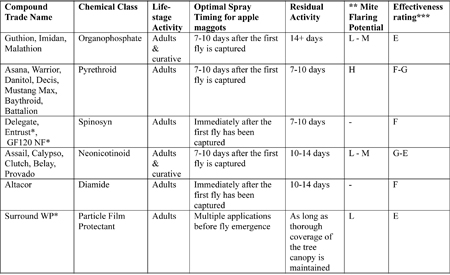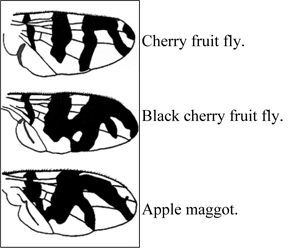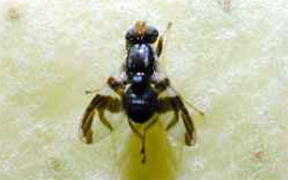Monitoring and management strategies for apple maggot in 2010
Editor’s note: This article is from the archives of the MSU Crop Advisory Team Alerts. Check the label of any pesticide referenced to ensure your use is included.
Apple
maggots (AM) overwinter as pupae and are developmentally ready to emerge
as adults in early summer (900 growing degree-days base 50). Peak
emergence generally occurs between 1,400 and 1,700 growing degree-days
but is highly dependent on site-specific weather conditions. In 2010,
most apple producing regions achieved 900 GDD the third or fourth week
of June, and rain events provided good soil moisture conditions for
apple maggot emergence. Low levels of apple maggot adult emergence have
been detected at the MSU Trevor Nichols Research Complex in Fennville for the last three weeks.
Monitoring adult apple maggot flight is key to effective management of
this pest. Adult activity can be monitored using yellow sticky boards
with ammonium bait, or a red sphere trap covered with an adhesive and
baited with synthetic fruit volatile. The yellow trap is most useful
during the pre-oviposition period when newly emerged females are
actively feeding. The red sphere trap mimics the ripening fruit that
flies are attracted to during egg-laying, and is effective throughout
the season. Comparisons of the two trap types in Michigan have revealed
that the red sphere baited with fruit volatiles is the most effective,
consistently catching three to four times more flies. Traps should be
placed on the south-facing side of trees in perimeter rows because most
flies are expected to be immigrating from wild hosts outside the
orchard. Optimally, traps should be checked twice weekly starting just
before 900 GDD base 50ºF until the first fly is captured, then once a
week thereafter to indicate the end of the flight.
Identifying apple maggots generally requires the use of a 10X hand lens.
Adults are dark flies, approximately 6 mm in length. The most
characteristic feature of the fly is the dark pattern on their wings
(Figure 1). These wing-banding patterns are used to differentiate
between fruit fly species. Apple maggot has four distinct black bands
toward the wing tips, as seen in the accompanying illustration. Further
identifying characteristics for the apple maggot include a white spot on
the back of the thorax, and white bands across the top of the abdomen.
The greater the number of traps deployed per block, the greater the
confidence level in basing treatment decisions on fly catch. Place at
least two traps along borders that historically have been a source of
infestation. Proper trap maintenance is crucial to trap effectiveness.
Over time, the adhesive can be fouled by leaves, twigs, other insects
and debris. Remove debris and insects each time traps are checked. The
adhesive should then be evenly redistributed. In determining control
treatment timing, on-farm fly catches should be used in conjunction with
regional trapping information. Basing treatment decisions solely on
regional information may lead to unnecessary insecticide applications.
If you employ a good trapping program, a control treatment for apple
maggots is not warranted until flies are captured on your farm. If flies
are trapped on-farm, and a regional trap catch was recorded prior to
the on-farm fruit fly capture, the treatment should be timed based on
the earlier regional capture. This conservative approach is the best way
to ensure that the control is applied prior to egg hatch. Chemical
control of apple maggots is focused almost entirely on the adult, with
the goal of preventing egg-laying.
Upon emergence there is an eight to 10 day period before female flies
begin to lay eggs. During this time, they are searching for nutritional
sources needed to become sexually mature. After female flies complete
this pre-oviposition period and have mated, they will seek out fruit for
egg-laying. They lay eggs just under the skin of ripening fruit with a
needle-like ovipositor, making visual detection of the puncture wound
difficult to distinguish from lenticels on the apple surface. Fly
larvae, called maggots, hatch from eggs within a week and begin to feed
in the flesh of the fruit. Maggot infestations will sometimes cause
fruit to abort, but often the fruit will hang till harvest. Mature
maggots drop out of fruit and enter the ground, where they pupate,
starting the next generation’s life cycle.
Control of the apple maggots has been traditionally achieved with
organophosphate insecticides, like Guthion and Imidan, but some label or
processor restrictions may limit their use near harvest. Synthetic
pyrethroid compounds, like Asana, Warrior, Danitol, Decis, Battalion,
Mustang Max and Baythroid XL, are also toxic to adult fruit flies, but
are generally viewed to be moderately effective because they have a
shorter field residual. There are several new reduced-risk and
OP-replacement insecticide products that include apple maggots on their
labels. The neonicotinoids Calypso, Clutch, Belay, Provado and Assail
are labeled for apple maggot control. All three have performed well
against apple maggots in small plot field-performance trials. Calypso
and Assail have also performed well in on-farm trials conducted in
Michigan over the past few years. The Spinosyn compounds Delegate and
Entrust are highly active on APPLE MAGGOTS when ingested, but have shown
to be only fair control materials in field trials with high pest
pressure, thus are labeled for apple maggots suppression only. The new
Diamide material Altacor is similarly active on apple maggots, and is
labeled for population suppression.
GF120 NF Fruit Fly Bait (spinosad) is registered on pome fruits for
control of apple maggots and is listed by the Organic Materials Review
Institute (OMRI) for use in organic production. Because the primary
route of entry is through ingestion, applying this product during the
fruit fly pre-oviposition period is important for optimal performance.
GF120 must be applied with specialized equipment, and is designed for
low-volume application. Field efficacy data is encouraging, but we have
limited experience with this novel tool to date.
The use of SURROUND WP for fruit fly control is based on creating a
protective barrier between the plant and the pest that 1) reduces host
recognition of the pest, and 2) prevents adult oviposition (egg-laying).
Because it is not toxic to adult flies like conventional contact
poisons, complete coverage of the plant is critical. Multiple
applications are typically needed to attain initial coverage; further
sprays may be necessary to respond to wash-off from rain or excessive
wind. Field trials indicate that when adequate coverage is maintained,
excellent fruit protection can be achieved.



 Print
Print Email
Email







